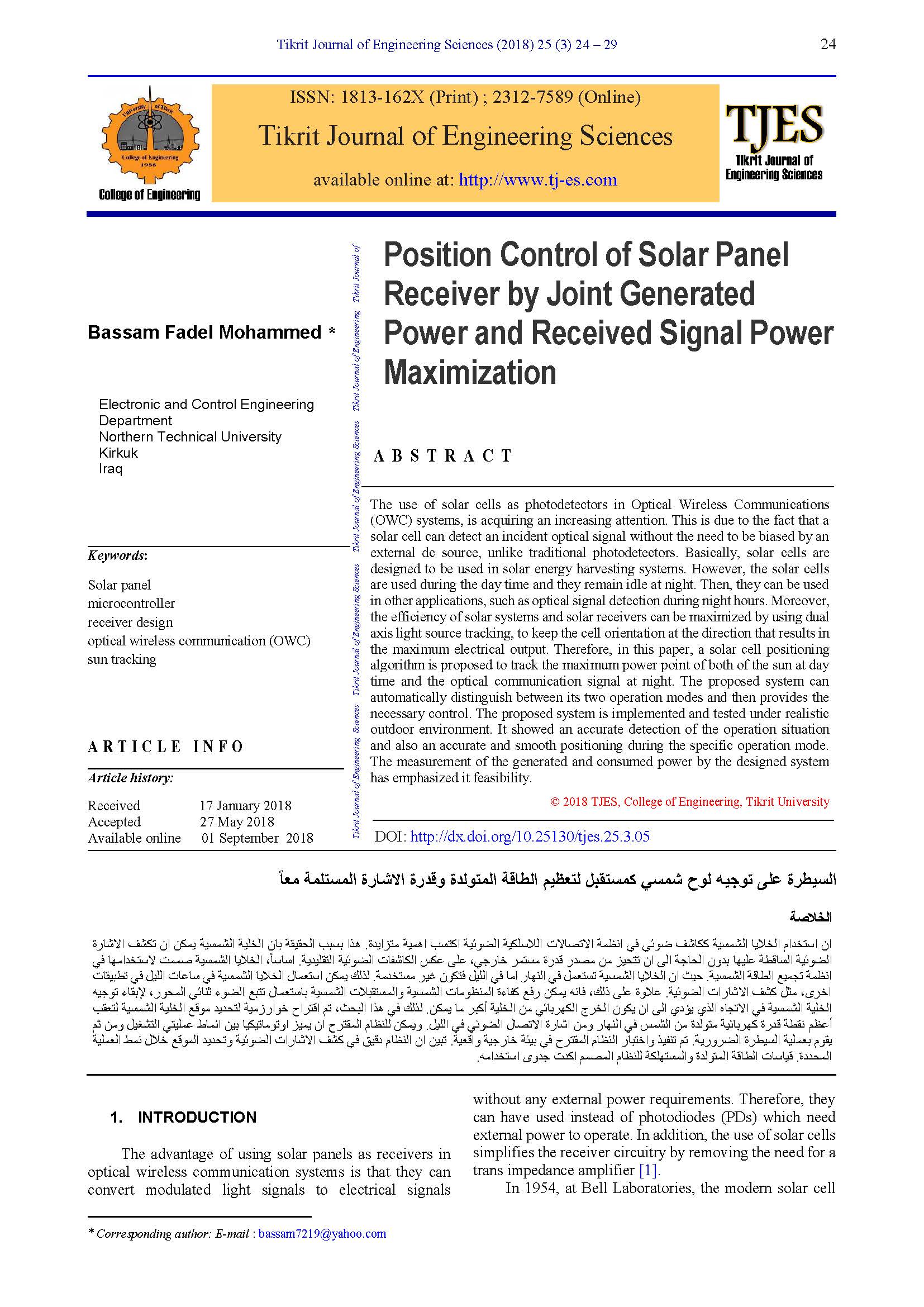السيطرة على توجيه لوح شمسي كمستقبل لتعظيم الطاقة المتولدة وقدرة الاشارة المستلمة مع ا
محتوى المقالة الرئيسي
الملخص
ان استخدام الخلايا الشمسية ككاشف ضوئي في انظمة الاتصالات اللاسلكية الضوئية اكتسب اهمية متزايدة. هذا بسبب الحقيقة بان الخلية الشمسية يمكن ان تكشف الاشارة
الضوئية الساقطة عليها بدون الحاجة الى ان تتحيز من مصدر قدرة مستمر خارجي، على عكس الكاشفات الضوئية التقليدية. اساسا،ً الخلايا الشمسية صممت لاستخدامها في
انظمة تجميع الطاقة الشمسية. حيث ان الخلايا الشمسية تستعمل في النهار اما في الليل فتكون غير مستخدمة. لذلك يمكن استعمال الخلايا الشمسية في ساعات الليل في تطبيقات
اخرى، مثل كشف الاشارات الضوئية. علاوة على ذلك، فانه يمكن رفع كفاءة المنظومات الشمسية والمستقبلات الشمسية باستعمال تتبع الضوء ثنائي المحور، لإبقاء توجيه
الخلية الشمسية في الاتجاه الذي يؤدي الى ان يكون الخرج الكهربائي من الخلية أكبر ما يمكن. لذلك في هذا البحث، تم اقتراح خوارزمية لتحديد موقع الخلية الشمسية لتعقب
أعظم نقطة قدرة كهربائية متولدة من الشمس في النهار ومن اشارة الاتصال الضوئي في الليل. ويمكن للنظام المقترح ان يميز اوتوماتيكيا بين انماط عمليتي التشغيل ومن ثم
يقوم بعملية السيطرة الضرورية. تم تنفيذ واختبار النظام المقترح في بيئة خارجية واقعية. تبين ان النظام دقيق في كشف الاشارات الضوئية وتحديد الموقع خلال نمط العملية
المحددة. قياسات الطاقة المتولدة والمستهلكة للنظام المصمم اكدت جدوى استخدامه.
المقاييس
تفاصيل المقالة

هذا العمل مرخص بموجب Creative Commons Attribution 4.0 International License.
THIS IS AN OPEN ACCESS ARTICLE UNDER THE CC BY LICENSE http://creativecommons.org/licenses/by/4.0/
##plugins.generic.plaudit.displayName##
المراجع
Wang Z, Tsonev D. On the design of a solar-panel receiver for optical wireless communications with simultaneous energy harvesting. IEEE 2015; 33 (8): 1612-1623. [2] Dutta A. Prospects of nanotechnology for high-efficiency solar cells. 7th ICECE: pp. 347-350; 2012. [3] Reddy PJ. Science & Technology of Photovoltaics. 2nd ed. Leideu, The Netherlands: CRC Press, 2010. [4] Manna TK, Mahajan S. Nanotechnology in the development of photovoltaic cells. ICCEP: pp. 379-386; 2007. [5] Green MA. Third generation photovoltaics: Ultra-high conversion efficiency at low cost. Progress in Photovoltaics: Research and Applications 2001; 9 (2): 123-135. [6] Razykov T, et al. Solar photovoltaic electricity: current status and future prospects. Solar Energy 2011; 85 (8): 1580-1608. [7] King RR et al. Solar cell generations over 40% efficiency. Progress in Photovoltaics: Research and Applications 2012; 20 (6): 801-815. [8] Green MA, Emery K, Hishikawa Y, Warta W. Solar cell efficiency tables (version 37). Progress in Photovoltaics: Research and Applications 2011; 19 (1): 84-92. [9] Mims F. Light-comm. Element Electron 1972: 29-95. [10] Elgala H, Mesleh R, Haas H. Indoor optical wireless communication: Potential and state-of-the-art. IEEE Communications Magazine 2011; 49 (9): 56-62. [11] Öztürk A, Alkan S, Hasirci U, Tosun S. Experimental performance comparison of a 2-axis sun tracking system with fixed system under the climatic conditions of Düzce, Turkey. Turkish Journal of Electrical Engineering and Computer Sciences 2016; 24 (5): 4383-4390. [12] Gabe IJ, Bühler A, Chesini D, Frosi F. Design and Implementation of a Low-Cost Dual-Axis Autonomous Solar Tracker. PEDG, IEEE 8th International Symposium, 2017. [13] Kim SM, Won JS. Simultaneous reception of visible light communication and optical energy using a solar cell receiver. ICTC, IEEE International Conference, 2013. [14] Chen HY, et al. Passive optical receiver for visible light communication (VLC). TENCON, IEEE Region 10 Conference, 2015. [15] Hsu CW, et al. Visible light positioning and lighting based on identity positioning and RF carrier allocation technique using a solar cell receiver. IEEE Photonics Journal 2016; 8 (4): [16] Malik B, Zhang X. Solar panel receiver system implementation for visible light communication, electronics, circuits, and systems (ICECS), IEEE International Conference, 2015. [17] Wang Z, Tsonev D, Videv S, Haas H. Towards self-powered solar panel receiver for optical wireless communication. Communications (ICC), IEEE International Conference: 2014.





